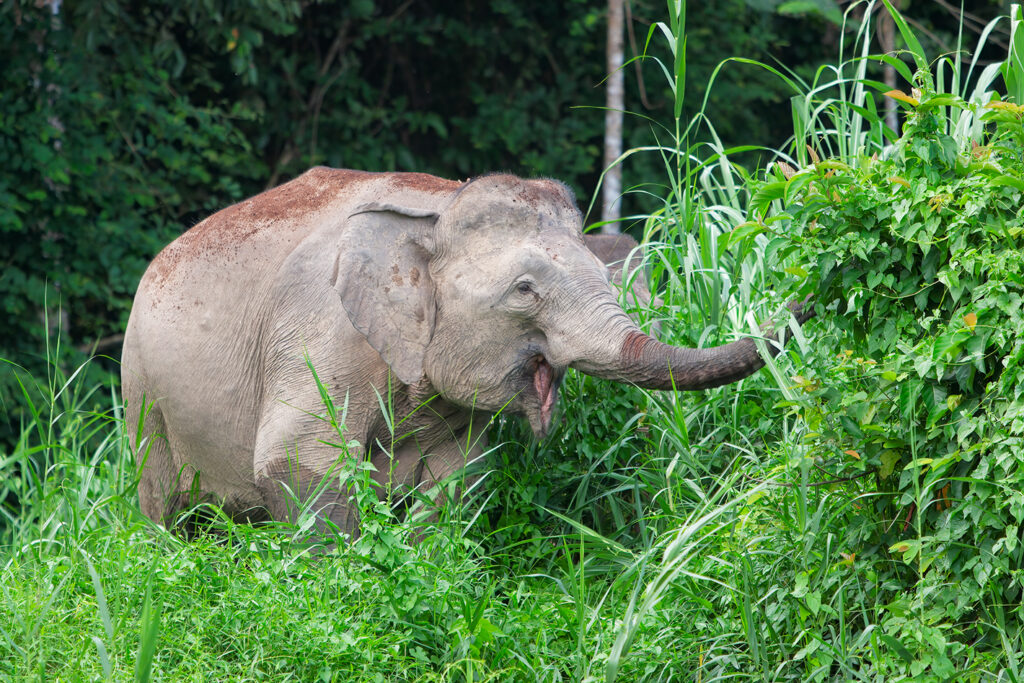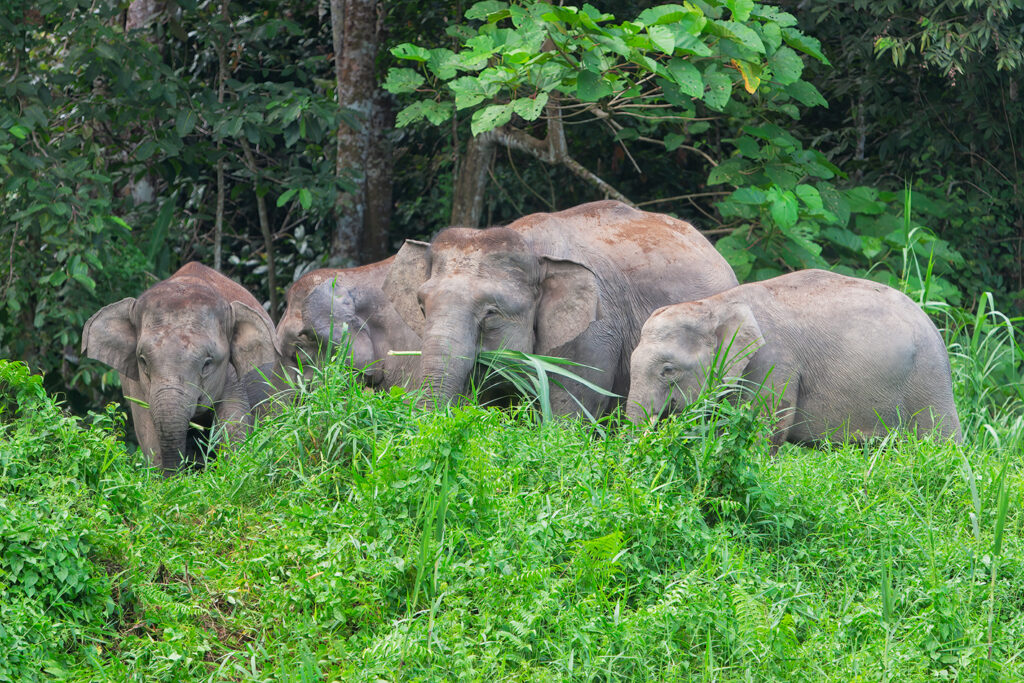My first up-close encounter with an elephant in the wild was an extraordinary experience, filled with intense and astonishing emotions. Its small, intelligent eyes looked at me calmly, communicating an ancient wisdom. The imposing and majestic size of the elephant instilled in me a sense of humility and profound respect for nature. Its graceful and tranquil movements, along with its calm and silent presence, connected me to the animal world and made me reflect on the beauty of biodiversity on our planet and the importance of its protection.
Undoubtedly, elephants are among the most iconic and fascinating animals in the animal kingdom. With their massive size, long trunks, fan-like ears, social behavior, and extraordinary intelligence, these magnificent creatures have always captivated human beings. While often associated with Africa, elephants have a vast geographical distribution and are divided into several species inhabiting different regions of the world. In this article, we will explore the different elephant species, their distribution, some distinctive characteristics, and also their conservation status.
Contrary to what was believed in the scientific world until a few years ago, genetics has shown that there are currently three living species on Earth:
• African Elephant (Loxodonta africana)
• Forest Elephant (Loxodonta cyclotis)
• Asian Elephant (Elephas maximus)
The Asian Elephant is recognized with four subspecies: Indian Elephant (E. maximus indicus), Sri Lankan Elephant (E. maximus maximus), Borneo Pygmy Elephant (Elephas maximus borneensis), and Sumatran Elephant (Elephas maximus sumatranus).
As a general description, elephants are large animals with relatively small eyes and large, movable ears. They are equipped with two ivory tusks and a trunk, derived from the fusion of their nose and upper lip; this organ is extremely versatile, prehensile, and has numerous nerve endings. They have weak eyesight, compensated by highly developed smell and hearing. Being herbivores, they mainly feed on tree foliage, bark, and fruits. Requiring large quantities of food daily.
Male elephants, upon reaching sexual maturity, often display a restless character, which can sometimes lead to episodes of aggressiveness, even towards humans. The period of maximum excitement, during which they are most dangerous, is called must.
Elephants are not a monogamous species. Their social structure is complex and based on strong family bonds, organized into groups of related females led by a matriarch. Female herd members often stay together for their entire lives and take care of the young generations. Near the main group, there are small groups of males that compete among themselves for mating hierarchy. The gestation period for females is approximately 21 months, and they usually give birth to a single calf. Twin births are extremely rare, accounting for less than 2% of all births.
African Elephant (Loxodonta africana):
The African Elephant is the largest land animal on Earth. Male individuals can reach heights of over 3.5 meters and weigh up to 7 tons, while females are generally smaller. One of its most noticeable features is its large fan-like ears, which not only contribute to its unique appearance but also play a vital role in cooling the body during hot savannah days. They live in various regions of the African continent, primarily in savannas, grasslands, and forests of sub-Saharan regions.
The African Elephant is predominantly herbivorous and feeds on a wide range of plants, including grass, shrubs, fruits, leaves, and bark. With their voracious appetite, they play a crucial role in shaping the surrounding environment, creating open spaces in the vegetation and influencing the plant growth cycle.
Despite their size and strength, African elephants are at risk of extinction due to human activities. Illegal ivory hunting is one of the main threats to their survival. Additionally, the loss of their natural habitat due to human expansion and climate change has a negative impact on the species. Numerous organizations are working hard to protect these magnificent creatures by combating illegal hunting and preserving their natural habitats.
Forest Elephant (Loxodonta cyclotis):
Similar to the African Elephant but slightly smaller, this species is found in the forests of Central and West Africa. It is distinguished by slightly rounder ears and a more convex skull compared to the African Elephant This species is also threatened by poaching and the reduction of its natural environment.
Asian Elephant (Elephas maximus indicus) (Elephas maximus maximus):
The Asian Elephant, also known as the Indian Elephant and the Sri Lankan Elephant, used to inhabit various regions of South Asia, but today, it is primarily found in India, Nepal, Bhutan, Bangladesh, and Sri Lanka. This species is slightly smaller than the African Elephant and is characterized by smaller ears, a more rounded back, and often less developed tusks in females. Adults can reach a height of about 2.7 meters and weigh between 2.7 to 4.5 tons. Asian elephants occupy a wide range of habitats, from dense rainforests to open grasslands and alluvial plains. They are highly adaptable and can survive both in protected environments and more anthropogenic areas, often coming into conflict with human communities as they search for food or traverse inhabited territories. However, illegal hunting and deforestation have reduced their population, leading them to have a vulnerable conservation status. The Asian Elephant holds a deep cultural and mythological significance in Hinduism. For millennia, these magnificent creatures have been symbols of strength, wisdom, good luck, and prosperity. In Hinduism, the god Ganesha, depicted with an elephant head, is one of the most revered and well-known deities. Ganesha is considered the lord of beginnings, the remover of obstacles, and the bringer of good fortune, and is often invoked before starting new projects or ventures.
Elephants have also been and are still employed in cultural and religious events, such as ceremonial processions and festivals, adding a sense of majesty and grandeur to these celebrations.


Sumatran and Borneo Elephants (Elephas maximus sumatranus) (Elephas maximus borneensis):
These two subspecies are also known as pygmy elephants. They are considerably smaller than the other Asian subspecies and inhabit the islands of Borneo and Sumatra. They have a shorter stature and more rounded skull. Adult individuals reach a height of about 2.5 meters and weigh between 2.5 to 4 tons. These elephants thrive in various types of habitats, from coastal jungles to alluvial plains, wooded hills, and swamps.
They represent a unique natural treasure, unfortunately at risk of extinction due to human activity and environmental threats.
As a result of agricultural expansion, logging, deforestation for oil palm plantations, and the consequent fragmentation of their habitat, elephants find it increasingly challenging to access food and water sources, leading them to venture into agricultural areas in search of sustenance. This inevitably results in conflicts between elephants and local communities, with negative consequences for both.
Elephants are incredible beings deserving of our admiration and protection. From the plains of Africa to the forests of Asia, these gentle giants play a crucial role in the ecosystems they inhabit. They act as ecosystem engineers, modifying their surrounding environment to promote the growth of other plants and providing a wide range of ecological services. Their movements aid in the dispersal of the seeds of the plants they consume, contributing to forest regeneration.
With all elephant species threatened by poaching, habitat loss, and conflicts with human activities, it is essential that conservation becomes a global priority.
Concerted efforts from governments, environmental organizations, and local communities are crucial to ensure that these magnificent animals can continue to thrive in their natural environment.
Only through increased awareness, education, and concrete actions can we ensure that future generations can admire elephants in all their splendor and contribute to maintaining the ecological balance of our planet.
